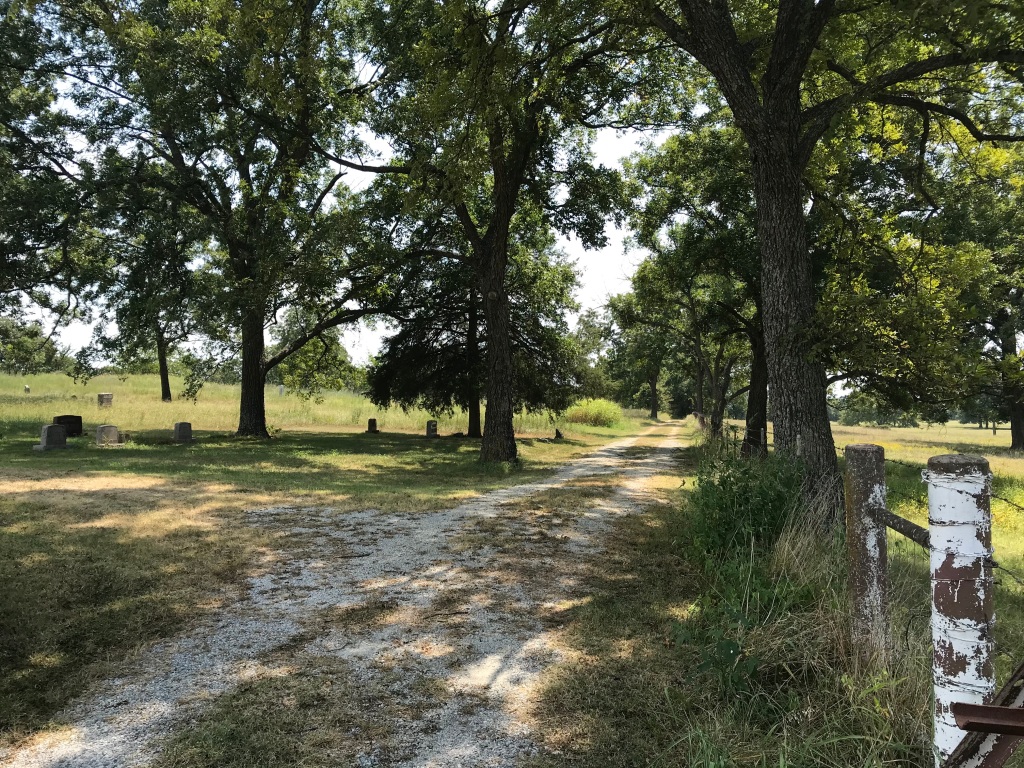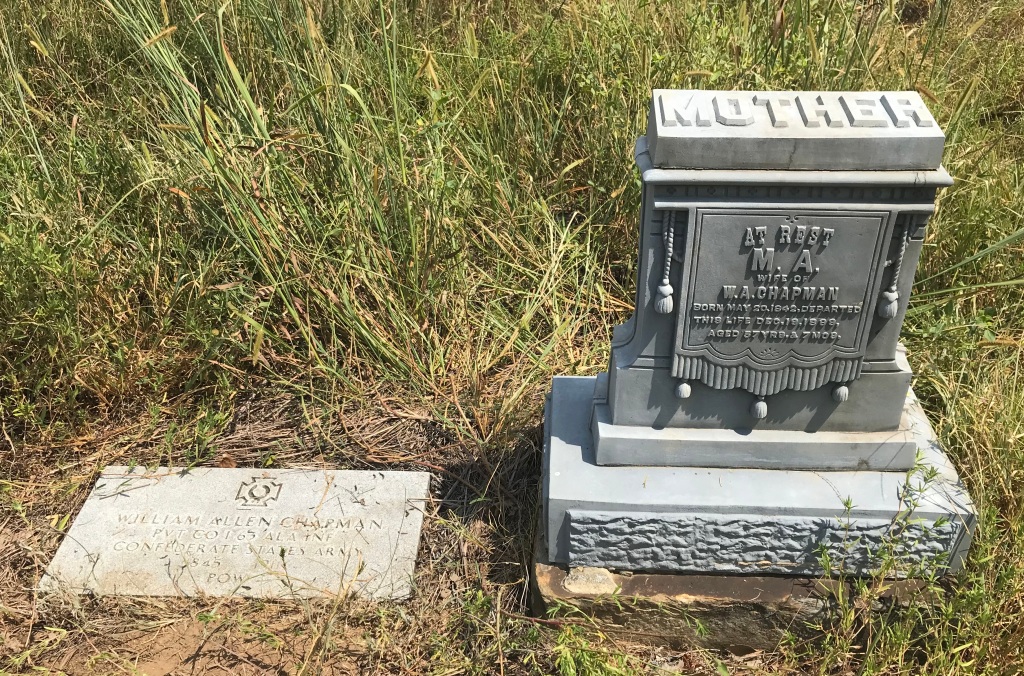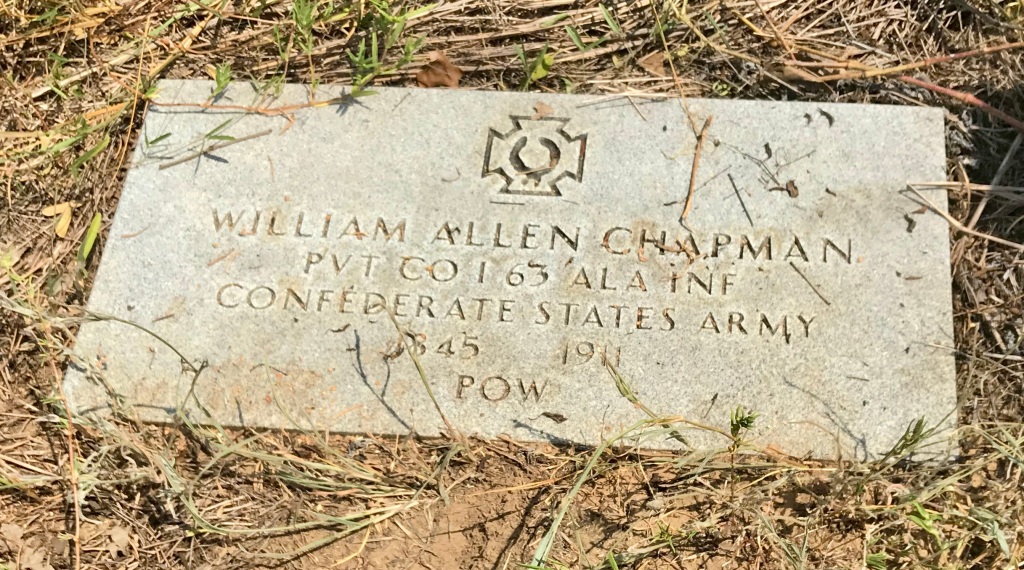By Christopher R. Rush
STONEWALL, OKLA. — On Saturday, Aug. 29, 2020, our immediate family — Chris and Sheryl Rush, along with son Evan and his wife Julia, and daughter Elizabeth — took the opportunity to drive to the historic Frisco Cemetery near Stonewall in south-central Oklahoma.
This cemetery holds the graves of a handful of Rush family ancestors, specifically the two grandfathers of Cecil Elsworth Rush Sr., my paternal grandfather. It is here in Stonewall, a tiny town south of Ada, that the Rush and Chapman family histories intersect.

Frisco Cemetery
The first observation I must make is that this old cemetery is in terrible condition. I believe it is through benign neglect as there are no recent burials and many of the descendants of those buried have long moved away from the area, like our family.
The graves are in deteriorating condition and currently, the grass has clearly not been mowed at all this year, perhaps longer. In some places, the grass and weeds are three-feet tall and completely obscure some of the smaller or ground-level headstones and markers.
After following directions from Oklahoma City on a collection of state highways and county roads we came upon the small unpaved drive leading to the Frisco Cemetery, tucked between private ranches and marked with just a small white metal sign.
Honestly, my heart sank when we drove up as I imagined it might be impossible to uncover the graves we were looking for due to the heavy brush. It was 98 degrees that day with nearly 50 percent humidity, so spending the afternoon bush-whacking with most of the family dressed in shorts and sandals was not feasible.
Fortunately, we were quickly able to locate the Chapman family plot not far from the gravel drive that circles the entire cemetery.
Below is a brief description of our greater Rush family ancestors buried here.
Malvina A. Mapp-Woodard-Chapman
The grave of Cecil Sr.’s maternal grandmother, Malvina A. Mapp-Woodard-Chapman, is fairly tall and quite well-preserved. The top bears in large letters, “MOTHER” and the inscription reads, “At Rest – M.A. – Wife of W.A. Chapman – Born May 20, 1842 – Departed This Life Dec. 19, 1899 – Age 57 Years and 7 Mos.”

It’s a beautiful headstone and likely replaced whatever marker previously existed immediately following her death. My guess is the current marker was replaced within the past 30 years or so.
Born Malvina A. Mapp in Tallapoosa, Alabama, she initially married a man named Gray L. Woodard (some spellings have it Woodward) in 1858 at the tender age of 16. Woodard entered the Confederate Army at the outset of the Civil War and died of some unknown malady in Richmond, Virginia in 1862, leaving her a widow at age 20. There are no reported children from this union that I have been able to discover.
Clearly, at this time in history, being a young widow was a very tenuous existence. She married William Allen Chapman, himself a Confederate Civil War veteran in Nov., 1865 after the close of the war. They had at least two children together – William Henry Chapman and Sally Chapman-Rush-Driver, Cecil Sr.’s mother and who my own father called, “granny.”
William Allen Chapman
William A. Chapman was born in 1845 in Coosa County, Ala. and entered the military at age 19 near the close of the Civil War. It is not clear if he volunteered or was conscripted, but nevertheless, he was a Private in Company I, 63rd Alabama Infantry in the Confederate States Army and served for an undetermined time as a prisoner of war (POW) at the close of hostilities.

From the research I have seen from Alabama Civil War military records, his company was populated entirely by teenagers, and mercifully, they were not thrust into action amid what was clearly a lost cause by that time.
He and his comrades were held back as a rear guard until the end of the war. It is unclear whether his company was captured, or surrendered, or simply held captive while being processed back to civilian life at the end of the war. But it drew the distinction of being a POW on his U.S. military-issue grave marker.
Like many other men at this time without inherited family wealth or property, he was listed as a farmer or farm laborer on subsequent Census reports.
William and Malvina made their home in Alabama (circa 1870) then Cooke County, Texas (circa 1880) where daughter Sally was born in 1883. Malvina passed away in 1899 while they made their home near Stonewall in what would become Pontotoc County, Okla., leaving him a widower.

The 1900 Census lists his residence as Township 2, Chickasaw Nation, Indian Territory. (age 55)
The last Census in which he was included was 1910, aged 65, and listed his address in Stonewall. He died the next year at the age of 66 and is buried next to Malvina in the Frisco Cemetery.
Daughter Sally (Chapman-Rush-Driver), is buried in the Rush family plot in the Henryetta, Okla. cemetery.
At about the same time the Chapman family migrated from the South (Alabama then Texas) to the new lands opening up in Oklahoma, a midwesterner and Union Army Civil War veteran named Jesse Rush migrated with his family from Indiana/Illinois, then to Kansas, and finally to the same small town of Stonewall, Okla.
Jesse Rush
Jesse Rush was born Jan. 13, 1836 in Montgomery County, Indiana. Subsequent Census records show that a Jesse Rush lived in Elkhart, Indiana in 1850 (age 14) with his parents, and the same in 1860 (age 24) where he worked as a farmer.
He volunteered for military service at the outbreak of the Civil War in 1861, mustering in Chicago, Ill. It was about this time also that we was married to Louisa Anna Adams (about 1862) in Indiana at age 26.

He was assigned to Company I of the 113th Illinois Infantry at Memphis, Tenn. and from there, most likely participated in the battle of Arkansas Post in the early stages of the war. According to Illinois military records, he most likely was not present for the more famous battle, the Siege of Vicksburg (Miss.) in which Gen. U.S. Grant won a decisive victory in the west. Approximately half the companies of the 113th (including Company I) had been dispatched to escort Confederate prisoners back to Illinois and did not rejoin their comrades until later in the war.
After another skirmish near Memphis late in the war, Jesse was honorably discharged as a private from military service on June 20, 1865 (age 29) at the cessation of hostilities.
The post-war 1870 Census listed his address as Douglas, Ill. (age 34). He and Louisa had seven children, including Dorra Belle Rush (1875-1953) who would later marry into the Chapman family, and a son — our direct Rush family ancestor (Winnie or W.E. Rush) Cecil Sr.’s father. (More about W.E. a bit further on.)
At some point after that, the family moved to Kanas (circa 1875) and resided there for some time. We have both Census records, as well a veteran organization records (Grand Army of the Republic) listing Jesse’s membership. His vocation was listed as farmer or farm laborer.
It should be noted that there also exists records for a “Jesse C. Rush,” from Elkhart, Indiana, but as near as I can research, these are NOT the same men, even though some recent family trees have confused/intertwined the two. In all the of the records I have come across, our ancestor Jesse Rush never uses a middle initial – not in the Census, not in military records, not in his membership rolls of the GAR, not the Family Bible ancestry page, not his grave stone, nor any other known source.
After showing multiple residences in Kansas through the 1870s and 1880s, the first official record of the Jesse Rush family in Oklahoma occurs in the Census of 1900 — at Township 2, Chickasaw Nation, Indian Territory. He would have been 64 years old.
It is unclear through my research so far when Louisa (sometime shown as Louisiana, or Lucy, and several other derivations on various documents) died, but she is not listed among the family members in Oklahoma. I will continue to research her fate (when she died, where she is buried, etc.)
We do know, however, that Jesse and some of his children (Dora B. and W.E.) were also present in Oklahoma at the turn of the 20th century and remained for at least a decade in which they would have had ample time to become acquainted with the Chapman family.
The last Census taken prior to his death in 1910 shows Jesse’s residence in Stonewall and has having remarried. He died shortly thereafter on Oct. 5, 1910 at the age of 74.
Two Families Intersect
I find it fascinating that two families – one from the South and one from the upper Midwest – intersect in the tiny town of Stonewall, Okla. prior to statehood and are responsible for several generations of descendants. Even though Jesse Rush and William A. Chapman came from different parts of the country, and served on opposing sides of the Civil War, their children — W.E. Rush and Sally Chapman — were married and started their own family from which many of us share our common ancestry.
I’d like to think that these two aging farmers and Civil War vets of modest means shared a smoke and conversation on one or the other’s front porch more than once.
It appears both of these families were of very modest means and made their living working with their hands and the sweat of their brow.
This brings me back to what would have been my 2x great Aunt, Dora Belle Rush-Chapman. She was widowed at a fairly young age (still doing research) and according to records, is responsible for ordering the government-issued grave marker for her Civil War veteran father, Jesse Rush. His lone marker stands approximately 20 yards in back of the Chapman plot.
Ironically, Dora B. Chapman’s own grave is a poured concrete slab with crudely etched markings bearing her name and date of death — a clear sign of very humble economic status. I am continuing research into this matter and how her unusual grave marker came to be.
Being a widow prior to the advent of Social Security and most of the other modern financial safety nets we take for granted today, meant that unless she remarried, she would have been entirely dependent on her own work and/or other family members to get by. In fact, she is listed among the household members of her eldest brother, Albert Rush, on at least one Census.
For more information about Stonewall, read https://www.okhistory.org/publications/enc/entry.php?entry=ST042
The Mysterious Death of W. E. “Winnie” Rush
There is precious little known about Cecil E. Rush Sr’s. father, W. E. Rush. From a research standpoint, the man is an enigma. Scant records exist that would provide clues as to his adult life and his mysterious death. There is a birth record for Oct. 4, 1880 in Kansas and a marriage license for his marriage to Sally Chapman (Oct. 4, 1900) in Carter, Okla.
Beyond that, I have found no records of his death or burial, or anything that would indicate the date or cause of his death, or even where he is buried.
There are a couple of potential explanations for this.

The first account that I have heard via relatives involves him working for the railroad company and falling sick and dying, then being hastily buried somewhere in the vicinity of Mounds, Okla. If he were buried near the tracks and his grave was only temporarily marked with a stake or wooden cross, or some other such crude marker, then it stands to reason that it would deteriorate and the precise location would be lost to time and weather. What is troubling is that there seems to be nothing of an official county record, newspaper obituary, or any other common source that would even provide a date of death.
As unsatisfying as that very plausible explanation may be, there is another possibility that is more troubling.
Late in life, during a conversation about the Rush family heritage, my mother (the late Geneva Rush) told me that my father (the late Robert F. Rush) had confided to her shortly after their marriage that the family held onto a dark secret.
Strikebusters (hired thugs) used clubs, hammers and other instruments to beat workers and break up a protest/demonstration. In the process, this grandfather was struck in the head. The resulting injury and the associated excrutiating pain being more than he could bear, he eventually took his own life.
It was this: That my father’s grandfather (I am assuming this story refers to W.E. Rush, but it could alternately refer to Barney T. Fox, father of my paternal grandmother, Elizabeth Fox Rush) took his own life. The story goes that this grandfather was employed by the railroad but participated in a strike or labor dispute of some kind that turned violent. Strikebusters (hired thugs) used clubs, hammers and other instruments to beat workers and break up a protest/demonstration. In the process, this grandfather was struck in the head. The resulting injury and the associated excrutiating pain being more than he could bear, he eventually took his own life.
At this time a century ago, suicide held even more stigma than it does today with major social and religious implications. It would have been considered a dark family secret and only spoken of in hushed tones, if ever at all.
I only heard this story related by my mother within the last decade or so of her life, but it certainly may shed some light on why there is scant records of W.E. Rush’s demise, or that of Barney Fox. I intend to keep digging to determine which of these men was the subject of this story. Records for the lives of both men are scant.
If any family member has additional information, or a different explanation, I would certainly welcome it as I am currently up against the proverbial “stonewall” in discovering any new details about these ancestors.
###
NOTE: I am actively researching this family and would welcome the opportunity to share any records I have with any other family members. This is not intended as a definitive history, but rather a work in progress. I can best be contacted via e-mail at cbobrush1@icloud.com


One thought on “The Rush and Chapman Families in Early Day Oklahoma”